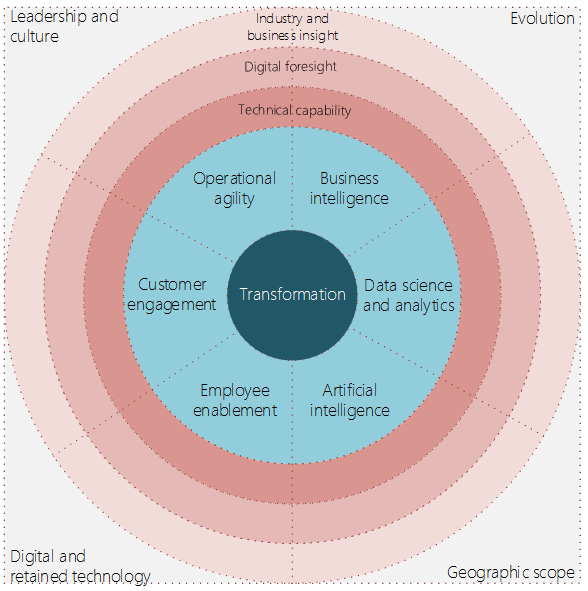
Transformation must start with your core business applications
Everyone in the Professional Services sector wants to implement projects that move them closer to the digital natives. But unless you tackle your core business applications first, and create a robust foundation for operational agility, you’ll forever be slowed down by the burden of legacy.
The way I see it, the primary focus of any transformation should be the applications at the core of your business – those that drive your operations, your B2B customer experience, your business intelligence, and the productivity of your workforce. Experimenting with new advances in analytics, AI and machine learning will certainly bring benefits, but true transformation can only be delivered once you’ve optimised the core of your business.
It takes a trinity to transform
The last two decades have seen huge evolutions in technology and a rapid convergence of business strategy and IT. As with many of my contemporaries, I started out as a purely technical consultant. But as my professional experience has grown over the years, I’ve increasingly found myself helping clients understand how technology can support their strategic goals.
This shift from IT being its own entity to becoming inseparable from business strategy has accelerated recently, and it’s happened across many different sectors and public services as digital native entrants have disrupted well-established norms.
In fact, it feels like a third element has now converged with the strategic and the technical: which is digital awareness. I believe that fusing this trinity is key to transformation – so if you’re deploying a new technical innovation to meet a perceived business need, you have to also consider how it will fit within your broader long-term digital landscape.
There’s absolutely nothing wrong in wanting to adopt AI or embrace machine learning for a project, programme or service. But these innovations will realise significantly more value when wired into the digital heartbeat of your organisation – and when they have the flexibility to adapt to longer-term market changes and shifts in priority.
Get your foundation set first
Making that happen can be daunting, of course. I’ve worked with a number of Professional Services firms who’ve had vast legacy infrastructures, federated working practices and disparate processes to unpick before they could establish a unified foundation on which to digitise.
Currently, my team is working with a global Professional Services company that has grown over the years through acquisition and now operates as a federation of separate companies. It’s embarking on a transformational journey to realise operational agility and efficiencies. This includes redesigning underlying data structures to support growth and respond to operating changes; redefining the KPIs it uses to measure business performance, and standardising commodity back-office processes across its global footprint.
We’re helping to build a scalable strategic data platform that will deliver business intelligence to inform its management decisions. We’ll then address the company’s analytics aspirations through models that explain and predict data, and that automate human decisions. With this digital platform and new-found agility, the firm will be far better set to take advantage of market opportunities and new insight services.
A methodology for success
In my view, turning ambitious change plans like these into reality starts by focusing on the following three pillars of digitalisation:
- Customer experience and engagement – ensuring you have a deep understanding of your customers thanks to applications that are tailored to the individual
- Operational agility – improving the productivity and capacity of your operations with powerful applications that help people work more efficiently
- Business intelligence – supporting leaders to make better decisions by giving them access to real-time dashboards and reports
You can then move on to the remaining three pillars, which will deliver the full benefits of digitalisation:
- Workforce enablement – a productive, facilitated and connected workforce enabling maximum flow and engagement
- Data science and analytics – the ability to explain your data by building models to predict trends on data
- Artificial intelligence – automation of human cognitive tasks using models that predict and automate human decision
This two-phase approach requires a far more consultative and collaborative engagement than the typical IT purchase, with a remit that goes far beyond the technology solution itself. It’s about bringing together the right people at the right time: businesspeople who understand the nuances of the sector, people with digital foresight who can translate immediate needs into long-term solutions, and skilled technologists who can deliver the technical implementation. And it must be underpinned by a culture and a framework that supports consistent change across sites, geographies and countries. You can read more about the approach here.

When it all comes together like this, and you have a solid digital core in place, you’ll be set to pursue innovations like data science, advanced analytics and artificial intelligence in a far more joined-up way across your business.
Свързани новини
Expertise
Where is the construction industry heading on its digital journey?
Our author Sabrina Hilmer explores what’s moving the industry. The construction industry has now reached the point of intensively dealing…
Expertise
Can we improve margins in the construction sector?
Construction is renowned for competitive pricing and tight margins, which the industry has been trying to improve for years. Faced…
